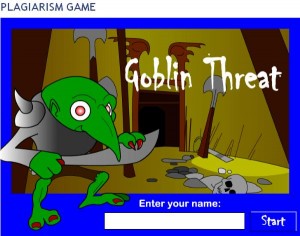Best Practices, Failing Students, and Killing Goblins
 During the 2014 Winter semester, I did an even better job than usual in following best practices for designing assignments to prevent plagiarism. Yet, there was a spike in the amount of plagiarized manuscripts submitted at the end of the semester.
During the 2014 Winter semester, I did an even better job than usual in following best practices for designing assignments to prevent plagiarism. Yet, there was a spike in the amount of plagiarized manuscripts submitted at the end of the semester.
Following best practices, I broke major assignments into parts. Early in the semester, I had students complete a basic research exercise where they were to find information using the following sources: a Wikipedia entry, a Google book, an academic article, a quality Internet site, and a YouTube video. Later, we went to the library where students were to find books and work with a reference librarian. Annotated bibliographies were submitted. More research was completed and bibliographies were resubmitted. Then students drafted the manuscripts for their lightning talks. During this process, I met with students to discuss their research and to provide coaching.
So what happened? The answer is surprisingly simple. Students didn’t do the work.
Because I don’t keep a grade book for participation (which includes homework and other day-to-day assignments), I was not recording scores on a daily basis. As a result, I didn’t notice the pattern of non-work until I was grading student binders at the end of the semester; binders that document the students’ participation during the semester.
After the semester ended, I did some quick statistics about participation; a component of the course worth 50% of the grade. After removing the 0% grades for students who did not submit their binders, I calculated average participation points. In my best class, students—on average—earned only an 80% score for participation. In my worse class, the average score was 68%. The other classes had scores between 72% and 76%.
Students are given full points for completing participation assignments. This means that, on average, students did not complete between 20% and 32% of the daily coursework. Even with a well designed course, if students do not complete 20%-32% of the daily work, it is hard for them to be successful on major assignments.
When looking at the major assignments that made up 50% of the course grade, the statistics are startling. Almost 40% of the students who submitted binders did not submit assignments worth 10%-50% of their final course grades. For the purposes of these statistics, plagiarized assignments are counted as having been submitted. Excluding the 12% of students who did not submit their binders, I discovered that approximately:
- 8% of students did not submit major assignments worth 10% of their course grade
- 9% of students did not submit major assignments worth 20% of their course grade
- 12% of students did not submit major assignments worth 30% of their course grade
- 2% of students did not submit major assignments worth 40% of their course grade
- 7% of students did not submit major assignments worth 50% of their course grade
Fortunately, for these students, I am willing to turn their failures into educational experiences. I gave about 16% of my students incompletes and have been offering to meet with students who have approached me since grades were posted.
In these cases, I will work with students to develop strategies for improving their grades and making referrals so that they can get appropriate assistance to develop skills or to take care of personal issues that interfered with their academic success. But giving incompletes and working with students after the semester has ended is both a time consuming and undesirable long-term strategy.
Beginning next semester, I will make some changes at the classroom level that I hope will help students succeed. Traditionally, I have date stamped completed homework during class. I plan to begin collecting and documenting the progress students are making—or not—on assignments that directly impact their final research projects. This way, I will be better able to identify and intervene on behalf of students who are setting themselves up for failure.
I will modify some assignments that will help students better learn the skills of summary and paraphrase. For example, there are times we read and discuss and article. I will ask students to first summarize the article or to paraphrase a section of it.
Because digital literacy is an important component of the class, I will ask students to create a web based portfolio of their research and writing; a project on which we will work throughout the semester. These portfolios will be integrated into the class in such a way that students will receive positive encouragement to keep with their assignments.
Finally, I plan to ask students to kill plagiarism goblins.
We no longer have students who routinely attended class and completed their homework. Therefore, as faculty, we need to work individually and in collaboration to help students learn the skills they need for success both inside and outside the classroom.
- –Steven L. Berg, PhD
Image from: Broussard, Mary. “Goblin Threat.” Snowden Library. 2011. Lycoming College. Web. I was introduced to Goblin Threat by my colleague, Professor Kim Dyer. Next semester, I will introduce it to my students.
[Statistics used throughout this blog entry are preliminary numbers based on a quick survey of the data.]
LEAVE A COMMENT